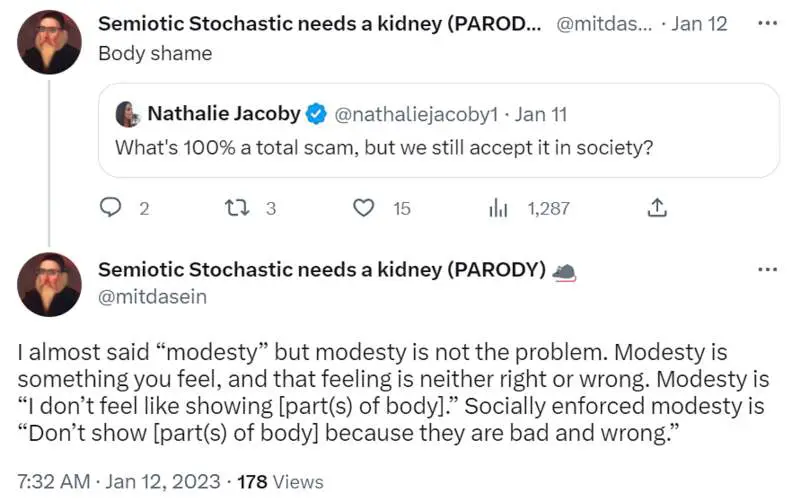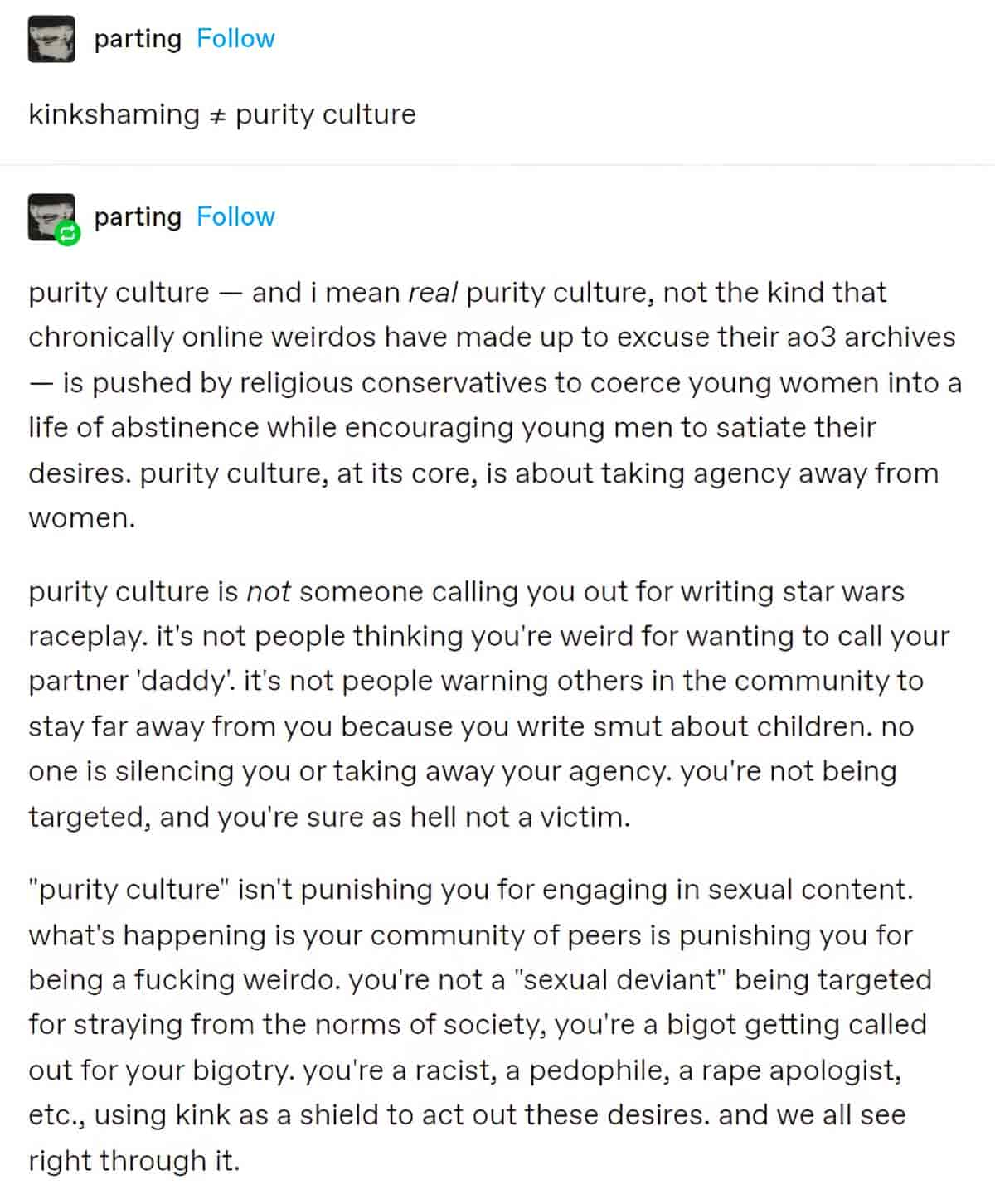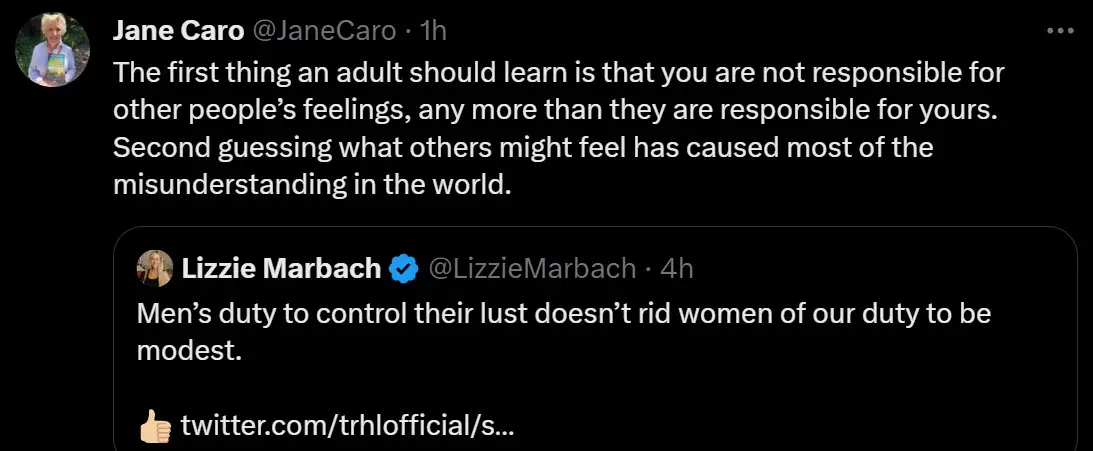- the quality or state of being unassuming in the estimation of one’s abilities.
- the quality of being relatively moderate, limited, or small in amount, rate, or level
What does modesty mean in relation to people, specifically femme people (mainly women and girls)?
- Appearing less (capable, smart, athletic, beautiful etc.) than you really are, to maintain the age-old gender hierarchy with men in positions of power
- Not being ‘too much’. Where women are expected to provide services of sex and care to men, being ‘too much’ can mean expecting equal care in return.
When I was young, I spent so much time trying to be right.
I tried so hard to damp myself down, to make myself smaller, to not talk so much or put my opinions so forcefully.
[…]
I was too emotional, too angry, too shrill, too opinionated, too loud, too talkative, too pushy, too dramatic, too … Well, pick your characteristic, I was too much of it.
What this felt like was that I was just intrinsically, inescapably wrong. I did not fit in. I made hundreds of resolutions to stay quiet, to be demure and modest, to defer.
[…]
Eventually, in desperation after years of therapy, it hit me that there was simply no right way to be a woman.
Jane Caro
Modesty is one of the virtues conservatives prefer in women, alongside domesticity, obedience and emotional warmth.

WHAT IS MODESTY CULTURE?
Modesty culture is a conservative subculture in which girls and women are held responsible for the sexual gaze of boys and men. This attitude is based on the flawed premise that boys and men are “visual creatures” (sexually aroused by looking at women and girls), and that girls and women are not “visual creatures”.
Conservatives tell their young people that respect is a two-way street, which on the surface looks fair and sensible. The ‘two-way street’: Girls dress modestly, and boys respect that.
This is not a two-way street in the slightest. Nothing more than the bare minimum (basic respect) is being asked of boys, unless you start with the mistaken belief that boys and men are are naturally wild, and that the veneer of civility extended to women and girls is already asking a lot.
Instead, the unintended consequence of modesty culture is this: Boys learn that girls who don’t dress modestly are not deserving of basic respect.
Another consequence — though fully intended in a patriarchy: girls and women must prioritise the thoughts, emotions and opinions of men before their own.
A Florida school is under fire this week for altering at least 80 female students’ yearbook photos to appear more ‘modest’. Hints of cleavage were blurred or erased, and shirts were poorly-photoshopped to cover more skin. A Bartram Trail High School representative told The New York Times that the girls’ pictures would have normally been omitted from the yearbook altogether for violating their dress code, and the alterations were “a solution to make sure all students were included.” How magnanimous!
Tellingly, a picture of the boys swim team in Speedos went untouched.
Jessica Valenti
Dress codes assume that it’s male students whose learning needs to be protected – and adult males who need protection from themselves. What girls need doesn’t rate consideration.
Jessica Valenti

IN MODESTY CULTURE GIRLS ARE TOLD THAT THEY HAVE ALL THE POWER
So, in Christian purity culture, girls are taught that we have to dress “modestly” because boys just can’t think straight when they’re in the presence of an attractive girl, the poor dears. The boys are so weak, and need the girls to help them.
I used to imagine it like this: Wow, as a girl, I possess in me this amazingly potent feminine power to control boys, but I must never use it. Oh, but if I did use it- if I let a bra strap show- if I wore a tight shirt- I could get the boys to do whatever I wanted. I would have a line of boys following me around while I teased them. They would stand at a respectful distance and look at me with hearts in their eyes, awed at just being in my presence. They would beg- beg me for a date, a kiss, etc- and I would say no, and they would never violate that “no.” All they could do would be continue to beg, or maybe bring me gifts, etc. I would have so much power.
But it’s not like that, it’s actually opposite.
[…]
in my fantasy about boys following me around and respecting my boundaries, well, that kind of sounds like celebrities with their fans and paparazzi. But here’s the key thing: Celebrities hire bodyguards for exactly that reason.
Tell me why the world is weird: Ex-evangelical Christian feminist. White American living in China. I believe in resurrection. “Getting the Power Dynamics Backwards“
ENFORCED BODY EXPOSURE IN SCHOOL UNIFORM
Our definition of ‘modest’ changes over time.
Between 1926 and 1962, male public high school students in America were required to swim naked. Some schools continued the practice for longer, and included middle school students. In the early 1970s, a large number of schools were still requiring it. The last American public schools discontinued the practice in the early 1980s.
See: When Naked Swimming was Required in Gym Class with Journalist Robin Washington, American Hysteria podcast, 23 January 2023
Why? Can’t say I understand it myself, though I suspect it had something to do with toughening boys up and enforcing hierarchy (teachers would have been clothed). Many of the male teachers would have been military trained. School was run in a far more militaristic fashion until those men retired. Ostensibly it had something to do with hygiene. But for girls, it was supposedly healthier for them to wear clothing.
I may find this practice hard to believe had I not been to an intermediate school in New Zealand where, at the end of the 1980s, girls (but not boys) were required to wear green Adidas knicker shorts, thereby revealing the entirety of legs. (Boys wore much longer shorts.) These shorts were literally the shape of briefs, made of towelling. This dress standard was strictly enforced. Not only that, but girls were forced to change into PE clothing before assembly, and our creepy male teacher was very obvious in his gaze, which fell on the girls who were further into adolescence.
Dress Codes: How the Laws of Fashion Made History
Dress codes are as old as clothing itself. For centuries, clothing has been a wearable status symbol; fashion, a weapon in struggles for social change; and dress codes, a way to maintain political control. Dress codes evolved along with the social and political ideals of the day, but they always reflected struggles for power and status. In the 1700s, South Carolina’s “Negro Act” made it illegal for Black people to dress “above their condition.” In the 1920s, the bobbed hair and form-fitting dresses worn by free-spirited flappers were banned in workplaces throughout the United States.
Even in today’s more informal world, dress codes still determine what we wear, when we wear it—and what our clothing means. People lose their jobs for wearing braided hair, long fingernails, large earrings, beards, and tattoos or refusing to wear a suit and tie or make-up and high heels. In some cities, wearing sagging pants is a crime.
In Dress Codes: How the Laws of Fashion Made History (Simon & Schuster, 2021), law professor and cultural critic Dr. Richard Thompson Ford presents a history of the laws of fashion from the middle ages to the present day, a walk down history’s red carpet to uncover and examine the canons, mores, and customs of clothing—rules that we often take for granted. After reading Dress Codes, you’ll never think of fashion as superficial again—and getting dressed will never be the same.
New Books Network


MODESTY: A FASHION PARADOX
Modest fashion is a growing, global multi-billion-dollar market. As a fashion trend, it has increasingly made its way into high-profile runways, has been endorsed by celebrities, and profiled in major fashion publications and news outlets. Hafsa Lodi’s Modesty: A Fashion Paradox (Neem Tree Press, 2020) investigates how and why modest fashion became a mainstream global retail trend. It looks at the causes and key players behind the global modest fashion trend, while also exploring the controversies that surround the concept. Lodi interviewed over 40 important actors in the modest fashion movement, including designers, models, influencers, and entrepreneurs but also drew on personal experiences from her childhood in the United States and career as a fashion journalist in the Middle East to understand its history, evolution, and contradictions.
New Books Network
Like many teenage girls my age I had conflated sex with love, and I knew I wasn’t supposed to be having it, which put me in a spiritually precarious position. If a boy had sex with me, that would surely mean he loved me. If he loved me, then I would be desirable. My worries and preoccupations were not with if I wanted to feel good in my own skin, or if I even liked the boys who did like me — I was preoccupied with being just the right amount of consumable to be wanted at all by another person. And surely God, a loving God, couldn’t completely frown on someone wanting to be loved, right? Could that be a forgivable sin?
Asexuality, Purity Culture, and the Construct of Virginity, Elle Rose, member-only story on Medium
If you haven’t figured things out sexually, remember that there isn’t a deadline. If somebody is making you feel like there is, consider the possibility that they aren’t your pal.
Less Wrong (Marriage isn’t a deadline, either.)
I was explicitly told in my youth group as a teenager that chromosomes and body parts didn’t make a woman, behavior and attitude did. This wasn’t done from queer theory, but to contradict the “you can be anything you want to be” message girls were getting from some sectors of society – sure, you can go off and get a job and achieve things and get public acclaim, but at some point your gender will be damaged.
So it’s honestly insane to see these same sets yelling about chromosomes and biology when twenty years ago I had to earn being a girl by not being smarter than guys. And again: you’ll pardon me for not thinking of that crowd as bravely fighting for my rights, since whether gender is innate or not (and there seems to be some disagreement) the only real North Star in the conversation seems to be “the subjugation of women”.
So twenty years ago, most people didn’t think about trans people or if they did it was limited to a very specific transmedicalist narrative. The danger to gender conformity was everything we saw in the purity movement + working women + gender equality.
Dr. Laura Robinson, Aug 27, 2023
TOXIC POSITIVITY
Modesty and purity culture is not limited to clothing, but extends to every part of the female body’s presentation. Moreover, the control of women is not limited to Christianity, nor even to organised religion. Misogyny exists in almost every domain of society, across the globe.
To be fair, Christians aren’t the only ones trying to pull this [control of female bodies] off. There’s a lot of New Age sh!t out there. It’s very similar. The thing about Evangelical Christianity is, there’s this toxic positivity to it, super-duper cheerfulness, say only positive things, and giving Glory to the Lord! I just want to Praise– Half the things they say, I think, ‘What does that even mean?’ But you’re supposed to adopt a certain affect if you are to be seen as Holy and Righteous.
It’s the same in super New Age-y yoga. At some point someone decided that having super-duper good posture and speaking with like a passive-aggressive half-whisper like maybe you took half a doze of Xanax [was the ideal].
“F*ck You, Purity Culture | Ft. Nadia Bolz-Weber, Eric Skwarczynski, and Alice Greczyn”, A Little Bit Culty podcast, Wednesday 6 September 2023


